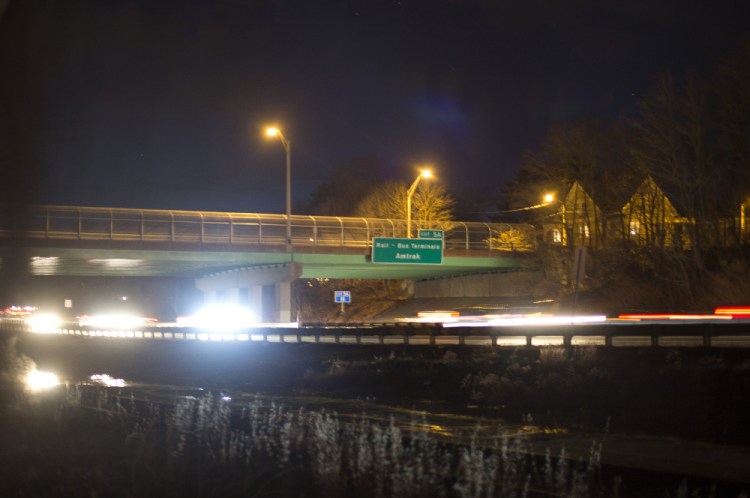The Maine Department of Transportation says a contractor has completed a cleanup of lead paint contamination near Interstate 295 bridges in Portland, a project that drew fire from a local lawmaker who is considering legislative changes to the contracting process.
Soil samples taken before and after the bridges were repainted showed elevated lead levels in some testing locations, particularly around the Deering Avenue Bridge, which crosses I-295 near Deering Oaks. In at least 10 instances, the contractor was required to do more remediation to bring lead down to acceptable levels – although not always below pre-work concentrations.
Transportation officials said the contractor, Southern Road & Bridge, has met all the terms of its contract.
“It was on-time and within budget,” said the department’s spokesman, Ted Talbot. “We do consider it to be an acceptable, completed project.”
But Rep. Ben Chipman, the state lawmaker from Portland who first aired concerns about paint dust left behind near pedestrian walkways, said he is considering whether to introduce legislation to address aspects of the contracting process. Chipman also questioned whether the responses of the transportation department and the contractor would have been as prompt if he and others hadn’t publicly raised the concerns about lead, a heavy metal that can affect mental and physical development in children.
“We shouldn’t have to follow them around,” said Chipman, a Democrat recently elected to the Maine Senate.
Southern Road & Bridge won a $1.9 million contract to remove corrosion and repaint four bridges crossing over or under I-295, on Deering Avenue, Preble Street, Forest Avenue and a railroad line.
In early October, Chipman and several others held a news conference near the Deering Avenue Bridge to call on the Department of Transportation to sever its contract with Southern Road & Bridge. After noticing paint dust on the Deering Avenue Bridge sign and under the bridge, Chipman and representatives of a labor union critical of Southern Road & Bridge collected soil samples for testing at an independent lab.
Those tests showed lead levels ranging from 1,900 parts per million to 32,000 parts per million – well above the federal standards of 400 parts per million near playgrounds and 1,200 parts per million in residential areas.
At the time, transportation officials said it would be “standard operating procedure” to test soils after all four of the bridge repainting jobs were complete. If those tests revealed lead levels more than 50 percent above levels before repainting – an allowance spelled out in the contract – the company would be required to do additional cleanup at those sites.
Test results provided to the Portland Press Herald for the three bridges used by pedestrians – Preble Street, Forest Avenue and Deering Avenue – showed the contractor had to do additional remediation at 10 sites. Six of those sites were around the Deering Avenue Bridge.
Overall, post-work lead levels were lower than pre-work levels at 19 of the 28 test sites but increased at nine sites. All 28 testing sites had post-work lead levels well below the 1,200 parts per million standard set by the U.S. Environmental Protection Agency for non-play areas.
Seven sites had final test levels that were slightly above the 400 parts per million standard set by the EPA for “lead in bare soil in play areas,” although the nature of the bridge sites makes it unlikely – or nearly impossible because of fencing – for children to play there.
In two particular sites, the post-work tests revealed lead levels in excess of both pre-work levels and the 400 parts per million standards even after the contractor removed 4 to 6 inches of soil.
Dwight Doughty Jr., director of the transportation department’s Office of Safety and Compliance, said it is unlikely that the type of work being done by the contractor would have caused contamination at such depths.
“In summary, after evaluating all the test results (pre- and post-) in aggregate at the project location, we have not required additional work because it is very unlikely (that) those two sample result entries over the 50 percent specification were the result of work performed by the contractor, and also because there is now 4 to 6 inches of clean material … in place over those locations,” Doughty wrote in an email.
Chipman said he had not yet seen the post-work test results, but expressed concerns about the large difference between the state’s pre-work figures and the samples his group had tested. And while Chipman said he was glad the company did more testing, he expressed surprise that the contract would allow a 50 percent increase in lead contamination after work was complete.
“Going forward, I don’t think we should be saying in contracts that they are allowed any pollution,” Chipman said. “They should be required to clean up their work. And if an increase is allowed, it shouldn’t be 50 percent.”
Chipman said he planned to talk with members of the incoming Legislature’s Transportation Committee about potential legislation to address those concerns and others about pollution and the contractor-selection process.
Send questions/comments to the editors.



